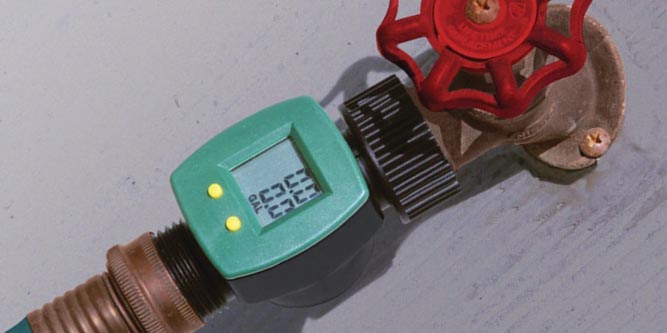Spring is right around the corner, which means it’s time to start thinking about your lawn and your garden. The grass may be dead in most places, or covered in snow, but don’t fool yourself. Before you know it, the trees will be budding, the birds will be singing, and the bugs will be biting. We could all do without the bugs, and we could also do without wasting our water. Green grass and a healthy garden can require a lot of water under the best of circumstances. The last thing you want to do is waste water unnecessarily. Not only does wasted water hit you in the pocketbook, it’s also bad for the environment.
There are many ways to make sure your garden is as efficient as possible. For example, many people use an outdoor faucet timer to ensure consistent scheduling. Many others install complete automatic sprinkler systems. Some take a middle road, using an aftermarket timer for one or two sprinklers. Another good option is to use a water flow meter. Now, a flow meter won’t water your lawn automatically or save you any water by itself. But it will help you monitor how much water you use for different tasks. This can be hugely helpful in and of itself, even if you don’t have a garden. Flow meters can also be used for filling pools, buckets, and even RV water tanks.
We’re about to review three of the best garden hose water flow meters online. We’ll start by looking at the Orbit Hose End Water Flow Meter. This is a simple meter that tracks total usage and usage this session, in gallons or liters. Next, we’ll review the RAINPOINT Water Flow Meter. This is a more full-featured flow meter with four different measuring modes. Finally, we’ll examine the Save a Drop by P3 International. This flow meter has a water-resistant housing, so it won’t get damaged in the rain. Let’s look a little closer at each of them, and see how they compare!
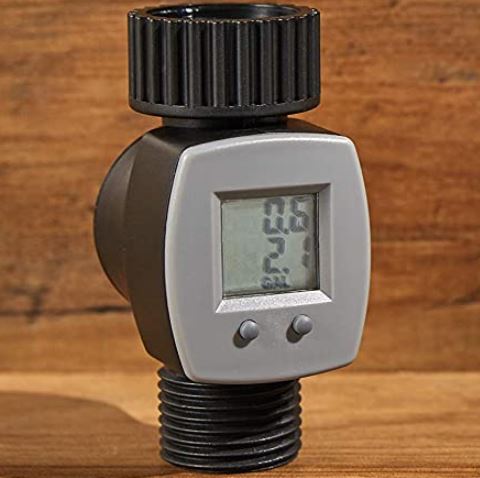
Orbit Hose End Water Flow Meter
Orbit is a manufacturer that knows a thing or two about watering equipment. We reviewed their WiFi irrigation sprinkler controller in the past, and we liked what we saw. Their Hose End Water Flow Meter is an affordable unit designed for homeowners or light commercial use.

The meter comes in a one, two, three, five, 10, or 20-pack. The bulk of the housing is black, with ¾-inch connectors at the top and the bottom. On the back, you’ll see a small round cover, which can be removed to change the CR2032 battery. A battery is included in the package, but they’re easy enough to buy at most shops.
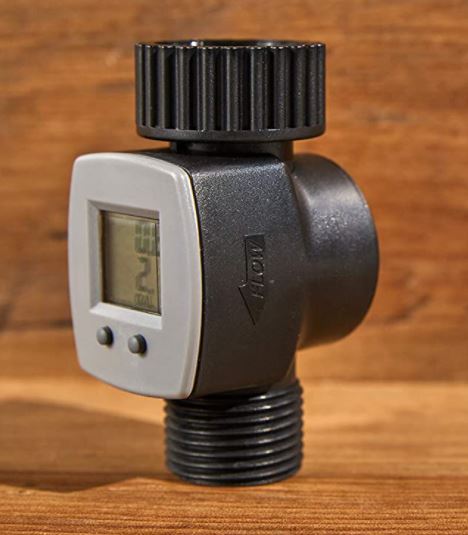
The grey front panel houses a simple LCD screen that shows two readings. At the top, you’ll see the water used during this session. Underneath, you’ll see the total water used. There’s a reset button, which can be used to restart from zero if you so desire. The other button is used to switch between liters and gallons. There’s one important thing we should note: the readings show the quantity of flow only. You won’t get a GPM reading or anything like that. That said, it’s easy enough to calculate your GPM. Simply start your water and a stopwatch at the same time. After a minute has passed, check how much water has gone through. This will give you your GPM.
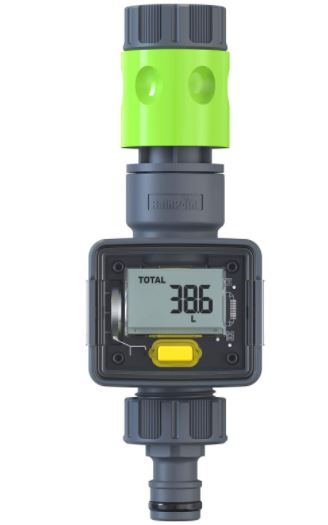
RAINPOINT Water Flow Meter
The RAINPOINT Water Flow Meter is a bit more advanced than the Orbit, and it looks like it. The housing is grey in color, with a box-shaped profile and a large LCD display. Both the top and the bottom have standard threaded connections. In addition, the kit includes a pair of quick-connects, which are compatible with other standard plastic quick-connects. On the back, you’ll see the battery compartment. Like the Orbit meter, the RAINPOINT takes a CR2032 battery, and comes with one to get you started.
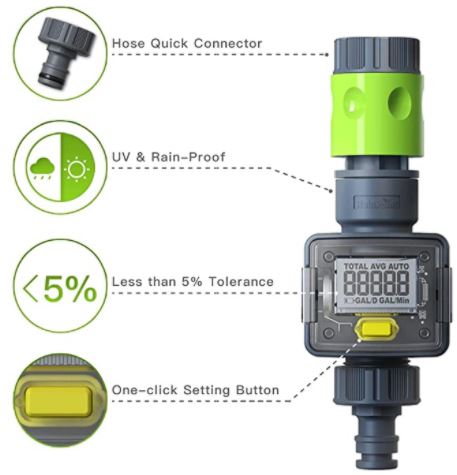
The operation is controlled by a single button, rather than two. This single button switches between four modes. You can also switch between gallons and liters by holding it down. This makes it very easy to operate, since there is literally zero learning curve. Put it in anyone’s hands, and they’ll be able to use it.
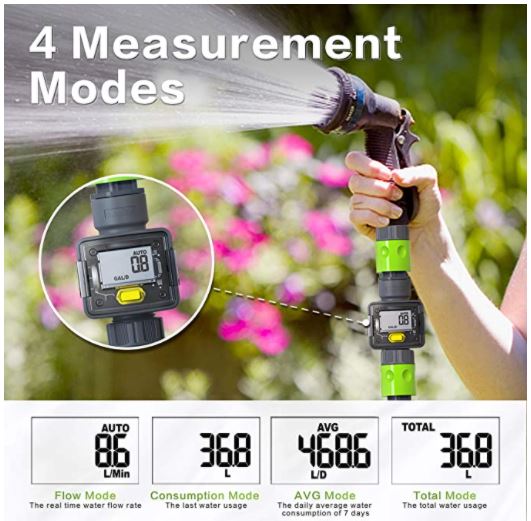
The first two modes are the same as the Orbit’s. You can measure total lifetime consumption, or consumption during a single session. This is fairly self-explanatory, and shouldn’t need any rehashing. However, the other two modes provide you with a wealth of more information. The first is flow mode. In this mode, the RAINPOINT meter will display the current GPM. This information is in real time, so you should expect some minor fluctuations. Even minor bends in the hose, for instance, can cause turbulence. This will cause the flow rate to move up and down slightly.
The fourth and final mode is the daily average. To get a reading for this mode, you need to leave the meter running for a full week. At the end, it will show you the average gallons per day over the past week. This is better for slow-running systems, or for systems with a timer or moisture sensor attached.
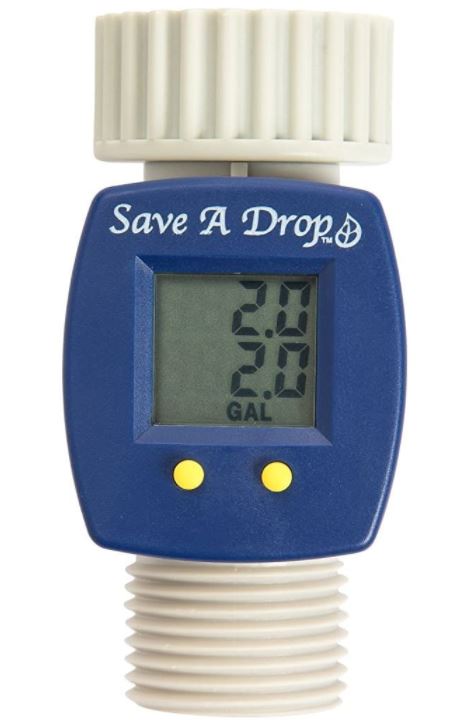
Save a Drop by P3 International
P3 International is another established manufacturer of testing equipment. Among other offerings, they make some good, affordable electricity usage monitors. Their Save a Drop water flow meter is white in color, with a blue faceplate surrounding the LCD display. It’s available in a one, two, or three pack, and has standard ¾-inch top and bottom connectors.

The Save a Drop has two buttons beneath the display. The first is used to switch between gallons and liters. The second is used to switch between partial and total use measurements. Like the Orbit meter, it only measures total flow, not flow rate. So, why does it cost so much more than the Orbit?
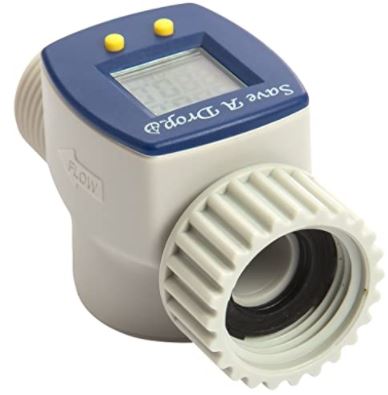
The answer is that the housing is waterproof. This might not seem like a big deal, but consider that you might want to leave your meter running outside. Sure, the inside is waterproof, but if rain damages your display, you’re not going to be happy. This waterproof design makes the Save a Drop ideal for taking longer-term measurements.
Garden Hose Flow Basics
Before we talk about measuring flow, we should talk about how flow is measured. There are actually two ways of measuring how much water goes through your hose. The first, and simplest measurement, is total flow. For instance, suppose you turn on your hose and fill a five-gallon bucket. You would have measured a flow of five gallons. By using a flow meter, you could measure the volume of an unknown container. Let’s say you just installed a small fish pond. If you want to know the exact volume, you could use a flow meter on your hose while you’re filling it.
But measuring volume is only so useful. After all, even a dripping faucet can fill a swimming pool, given enough time. A more commonly-used measurement is gallons per minute, or GPM. GPM is exactly what it sounds like: the number of gallons that flow through your hose in each minute. Different hoses and different homes have a different GPM. This depends mainly on three factors: the hose diameter, the water pressure, and the hose length. Here’s a quick overview each.
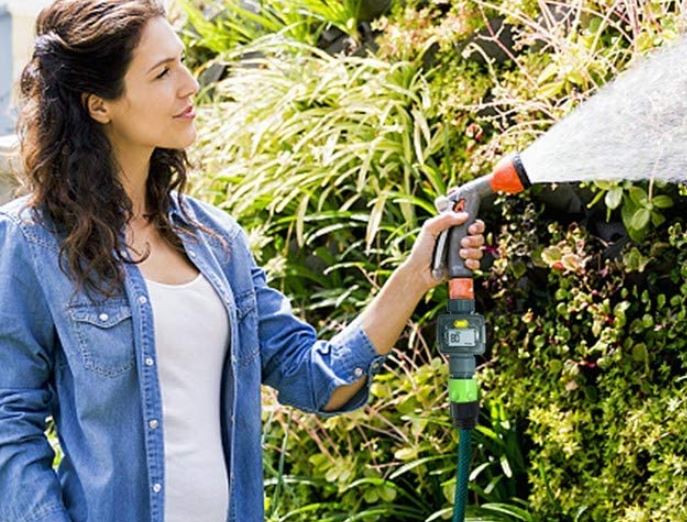
Almost all garden hoses use a standard ¾-inch connection. However the diameter of the hose can be very different. Light-duty hoses typically have a diameter of half an inch, while heavy-duty hoses are three-quarters of an inch in diameter. Everyday medium-duty hoses fall right in the middle, at ⅝ of an inch. Without getting too far off into the weeds, the larger the hose, the more flow it will allow for. Conversely, a smaller hose will allow fewer GPM through.
Along the same lines, the water pressure has a major impact. Most residential systems have a water pressure between 40 and 60 PSI. For even higher-pressure systems, many people install a regulator to lower the PSI to these levels. If you’re buying a hose and you want a certain flow rate, you’ll need to know the water pressure. Knowing the diameter of the hose will not be sufficient. If you have very high-pressure water, you should make sure your hose can handle it. Hoses will come with a PSI rating, which is typically over 60 PSI. That said, some light-duty hoses can fail at lower pressure.
The third factor that affects your flow rate is your hose length. The longer the hose, the lower the pressure will be at the outlet. This means that longer hoses will have proportionally less flow. For example, a ¾-inch, 25-foot hose on a 40 PSI system will have a flow rate of 72 GPM. A 100-foot hose on the same system will only have a flow rate of 18 GPM. For reference, a ½-inch, 25-foot hose on the same system has a flow rate of 24 GPM. As this example shows, the length of your hose can have an even more dramatic effect than the diameter!
Keep in mind that all of this assumes you’re running a hose with nothing else attached. Sprinklers, nozzles, and other devices can further restrict the flow. This isn’t necessarily a bad thing. When you’re trying to save water, it helps to use less of it to begin with. But it’s something you should be aware of when you’re taking your measurements.
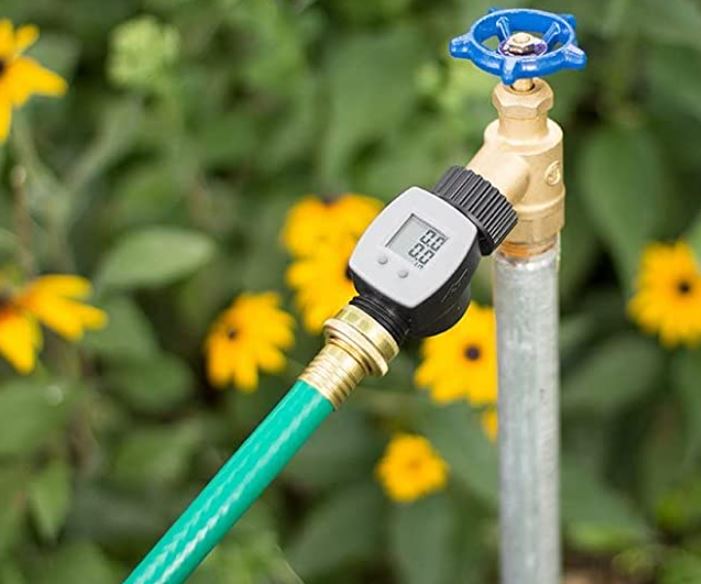
Garden Hose Flow Meter Basics
So, how does a flow meter work, and how is it used? The design is fairly simple. As water flows in, it passes through a tiny turbine. This turbine is attached to a sensor, which keeps track of the amount of water that flows through. The amount is then displayed on either a mechanical dial or a digital screen. More complex flow meters can also detect the GPM and other metrics.
The flow meters we’re looking at today all have the same basic design. A hose connects to one end, and the water flows out the other. You can also connect another hose, or a device like a sprinkler or nozzle, at the other end. You can even connect them to pumps, provided the pump outflow is a standard ¾-inch thread.
One thing you do want to be cautious about is using any of these flow meters for a long period. The inner turbines are mechanical parts, and will eventually fail someday. Use the meter for as long as it takes to get your measurement. But don’t leave it in line permanently. It’s all too likely to fail.
Final Verdict
So, which one of these water flow meters is the best choice? A lot depends on what you’re trying to achieve. We began by reviewing the Orbit Hose End Water Flow Meter. There’s nothing fancy about this one, and there doesn’t need to be. It’s made for homes and small businesses, and it’s meant to be as affordable as possible. If you’re trying to save money for your business, you can buy in a 20-pack, and get a quantity discount. That said, it only measures the quantity of flow, not the rate. If you need a more advanced meter, you’ll need to pay a bit more.
The RAINPOINT Water Flow Meter is a better choice if you need more advanced readings. It can show you a real-time GPM reading, which is what many people need when they choose a flow meter. The most impressive option, though, is the daily average. This makes the RAINPOINT meter ideal for applications with slow or irregular flow. You can figure out how much water you’re actually using, instead of making a rough approximation.
The Save a Drop by P3 International is the best choice if you need a waterproof meter. It’s not going to fail because it got rained on, or splashed by a sprinkler. That said, it only measures the amount of water flow, not the rate.
Meet Ry, “TechGuru,” a 36-year-old technology enthusiast with a deep passion for tech innovations. With extensive experience, he specializes in gaming hardware and software, and has expertise in gadgets, custom PCs, and audio.
Besides writing about tech and reviewing new products, he enjoys traveling, hiking, and photography. Committed to keeping up with the latest industry trends, he aims to guide readers in making informed tech decisions.

